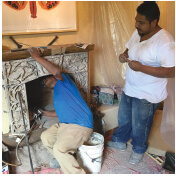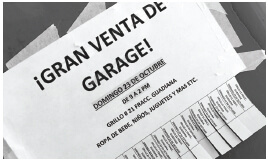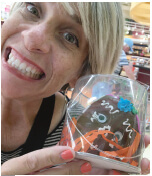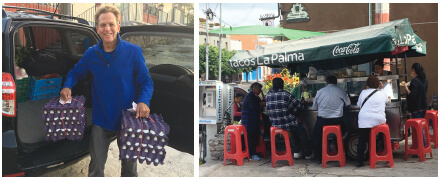Last April, my wife, Rhonda, and I left San Francisco, our home for fifty-two years, to become permanent residents in Mexico. “We’re driving a car looking in the rearview mirror, meaning that the environment in which you believe yourself to exist is always a past one, it isn’t the one you’re actually in,” said Alan Watts. Nothing could be truer of our new home in San Miguel de Allende.
San Miguel might be best described as a composite of Calistoga, Carmel by the Sea, Chinatown’s narrow back streets, Salinas, and, most definitely, Siena, Italy. Like any collage, the overlapping pieces aren’t neatly separated; experiencing the town feels like successive frames of a moving picture.
Though it might appear to an outsider as chaotic, our 17th century UNESCO World Heritage site, located at 6,000 feet in the central Mexican highlands, has for a longtime served as a cohesive system for 80,000 Mexicans. The 10,000 ex-patriots who arrived before us have in many cases also ‘drunk the Kool-Aid.’ One American neighbor told us that she enjoys blending in with a culture that exhibits more tradition, superstition and mythology.
Christian faith has it that Saint Michael, San Miguel’s patron saint, was sent to battle with Lucifer to banish him from Hades after he disobeyed God. St Michael’s combat with evil is acted out in the city’s main plaza, with copious exploding firecrackers and fireworks. The weekend fiesta and final eight-hour pageant, ending in the town square, Parroquia de San Miguel Arcangel, starts at 4 a.m. from outlying areas, bringing indigenous tribes of every stripe into town in full regalia: colors, feathers, drums, horsemen, including an angelic female dressed in light blue silk seated in the back of a white Mini Cooper flashing the Queen Elizabeth wave. During the finale I mingled with hundreds of others, camera borne aloft for two and a half hours, before staggering home to edit this experience down to fifteen minutes of video entertainment, https://vimeo.com/189339375
Within the expat community setting down roots from the United States, Canada and Europe, there are three social clusters: artists; volunteers, who help implement the business plans of others; and those frequenting the cocktail circuit’s Mobius strip. Crossover among these three groups is fleeting, and usually futile. Many new arrivals form non-government organizations that seek to change things: living conditions, rampant malnutrition, educational and legal systems, air, water and noise quality. A common thread is that all the expats have “left”. A self-selected socioeconomic group, we have, like Christopher Columbus, concluded that the only place on earth that’s really flat is back home, encumbered by history, routine and technologically accessible comforts. Here we have the possibility of remaking ourselves juxtaposed within a completely foreign environment.
Our journey is seen by friends and relatives in different lights. Some said that it’s crazy to settle in a place where we don’t know anyone; to us it’s one of the main reasons for taking the trip. Others admire our courage, though I’ll admit that for the first several months after arrival I was in a state of shock, as in “where am I ?” Some take comfort in our eventually “getting settled in”. In fact, there’ll never be a “there there”. We’ll always be minorities, outsiders, unable to become fully Mexican, unable to ever go back to where we were, now endowed with a different perspective.
Finally, there are friends who see the gesture as a logical progression of experimentation, like taking one more exotic vacation. But other than maintaining a small apartment in San Francisco for business purposes, we’ve permanently moved, demonstrating the principle that “kites can only fly against the wind”. This ain’t no weekend in Calistoga.
To further categorize fellow travelers as personality types, expats tend to make three kinds of living arrangements in San Miguel. The first personality does what Rhonda and I did. After visiting for a short or long time period – for us a single week; for others several years – these individuals purchase an existing home, typically fully furnished. The simplicity of this approach enables the lucky newcomer to immediately focus on more important aspects of their integration: replacing rubber belts and thermostats in appliances, locating leaking pipes and ancient root infestations deeply embedded in cement walls and rebar-reinforced patios; inviting various internally and externally well-established rodents to relocate, or die; and experimenting with ear-wear – aka ear plugs – to mitigate all manner of endearing sounds indigenous to the local population – loud fireworks – in perpetual celebration of every saint, departed relative or holiday.

The second kind of newcomer also purchases an existing home, but finds a property they can completely remodel. To them, the building is merely a structural shell in a good location crying out for a makeover, one in an imposing style to embody their wildest long-held fantasies. Gargantuan yard fountains; paintings hung on every vacant wall; white marble as far as the eye can see; multiple ovens and stoves; a refrigerator with space to house a frozen slain oxen; custom made furniture and shelving, often in shades of black; and a master bedroom fit for a medieval nobleman. This refurbishment entails knocking out numerous weight-bearing walls, adding patio roof decks, ripping out kitchens and baths and changing the surfaces of just about every part of the interior and exterior building skin.
One reason a do-over becomes so extensive is that as soon as the stairwell’s tile is changed, the living room floor no longer fits. And so on. There’s also an irrepressible impulse to modernize the look of the home, altering the ‘colonial’ style that’s ubiquitous throughout this 17th century town. While labor and materials appear dramatically low-cost by American standards, it soon becomes apparent that with few exceptions, Mexican logistics, time schedules, permits, architects and construction workers are highly unpredictable, especially after contracts have been signed. Crises soon emerge when a cadre of visiting relatives and rental schedules come face to face with mounds of dirt and high piles of rocks languishing for months in the front driveway.
The third type setting down roots in town don’t look for an existing structure at all, since nothing that predates their

arrival going back to ancient times seems suitable. Instead, they look to acquire vacant land, which in this overpopulated village is mostly available only on the periphery, near highways, or in more desolate areas with roaming dog packs and a fifteen minute car ride over potholed streets to summon a quart of milk. Many of these gorgeous structures, which include expansive yards with non-indigenous bamboo groves punctuated by, in some cases, a twenty five foot drop of recycling Yosemite-like waterfall, look and feel ‘dropped out of the sky’ from Architectural Digest, completely divorced from Mexico.
After three months living in San Miguel I made a four-day business trip to San Francisco last summer. Flying across the border I felt like a member of the International Space Station returning to earth. After a period of weightlessness, in suspended animation in this foreign land, I wondered how walking on terra firma would feel in more familiar American territory; in a word, discombobulating. By returning I donned an older wardrobe, clothes just recently discarded; I came back to the charms of an old girlfriend – San Francisco – a butterfly had reversed its process of metamorphosis, temporarily going back into the previous cocoon.

Rhonda and I are finally extricated from the technological trappings of one culture and re-installed into a new one, along with a new house containing many new windows. We’ve learned that if you come looking for a hamburger you might instead be more enthralled with a fish taco containing an intermingling of flavors impossible to describe. If this feels to you, dear reader, like an invitation to come visit, we’d welcome your arrival. But be careful. You might just end up like us!
In the face of it all, we San Francisco ex-patriots manage to maintain our faith in what lies at the end of the rainbow; the ‘view’ we’re discovering while looking through the ‘window’. Absent that we might reach the conclusion reported years ago by a young chap after his first day at elementary school. In a television show on which I appeared in 1956, Kids Say the Darndest Things, Art Linkletter asked the boy about his initial experience. “I’m not going back to that place”, the child exclaimed. “Oh, why is that?” Art replied. “I can’t read, I can’t write and they won’t let me talk,” he replied.


